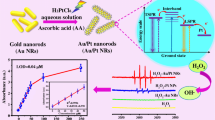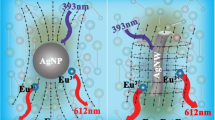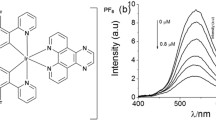Abstract
A plasmonic hot electron transfer-induced multicolor chromogenic system is described for label-free visual colorimetric determination of silver(I). The chromogenic system consists of plasmonic MoO3-x nanosheets with oxygen vacancies and Ag(I). Under white light-emitting diode (LED) excitation, energetic hot hole-electron pairs are formed on the surface of the blue MoO3-x nanosheets. The resulting hot electrons are transferred to Ag(I) upon which it becomes reduced. This results in the generation of yellow silver nanoparticles. Simultaneously, the hot holes lead to the oxidation of the MoO3-x nanosheets to yield colorless MoO3 nanosheets. Similarly, energetic hot hole-electron pairs can also be generated on the surface of AgNPs under white LED irradiation, which contributes to the reduction of Ag(I) and the oxidation of MoO3-x. Overall, a colorful transition from blue to green and finally to yellow can be observed. This multicolor chromogenic system was applied to the colorimetric determination of Ag(I) in the 33–200 μM concentration range and a 0.66 μM limit of detection, at analytical wavelengths of 430 and 760 nm. The method also is amenable to semi-quantitative visual determination of Ag(I).

Schematic representation of plasmonic hot electron transfer-induced multicolor MoO3-x-based chromogenic system for visual and colorimetric determination of silver(I).




Similar content being viewed by others
References
Linic S, Aslam U, Boerigter C, Morabito M (2015) Photochemical transformations on plasmonic metal nanoparticles. Nat Mater 14(6):567–576. https://doi.org/10.1038/nmat4281
Linic S, Christopher P, Ingram DB (2011) Plasmonic-metal nanostructures for efficient conversion of solar to chemical energy. Nat Mater 10(12):911–921. https://doi.org/10.1038/nmat3151
Boerigter C, Campana R, Morabito M, Linic S (2016) Evidence and implications of direct charge excitation as the dominant mechanism in plasmon-mediated photocatalysis. Nat Commun 7:10545. https://doi.org/10.1038/ncomms10545
Rao VG, Aslam U, Linic S (2018) Chemical requirement for extracting energetic charge carriers from plasmonic metal nanoparticles to perform electron-transfer reactions. J Am Chem Soc 141(1):643–647. https://doi.org/10.1021/jacs.8b11949
Aslam U, Rao VG, Chavez S, Linic S (2018) Catalytic conversion of solar to chemical energy on plasmonic metal nanostructures. Nat Catal 1(9):656–665. https://doi.org/10.1038/s41929-018-0138-x
Shi Y, Wang J, Wang C, Zhai T-T, Bao W-J, Xu J-J, Xia X-H, Chen H-Y (2015) Hot electron of Au nanorods activates the electrocatalysis of hydrogen evolution on MoS2 nanosheets. J Am Chem Soc 137(23):7365–7370. https://doi.org/10.1021/jacs.5b01732
Christopher P, Xin H, Linic S (2011) Visible-light-enhanced catalytic oxidation reactions on plasmonic silver nanostructures. Nat Chem 3(6):467–472. https://doi.org/10.1038/nchem.1032
Wang C, Nie X-G, Shi Y, Zhou Y, Xu J-J, Xia X-H, Chen H-Y (2017) Direct plasmon-accelerated electrochemical reaction on gold nanoparticles. ACS Nano 11(6):5897–5905. https://doi.org/10.1021/acsnano.7b01637
Christopher P, Xin H, Marimuthu A, Linic S (2012) Singular characteristics and unique chemical bond activation mechanisms of photocatalytic reactions on plasmonic nanostructures. Nat Mater 11(12):1044–1050. https://doi.org/10.1038/nmat3454
Voiry D, Shin HS, Loh KP, Chhowalla M (2018) Low-dimensional catalysts for hydrogen evolution and CO2 reduction. Nat Rev Chem 2(1):0105–0117. https://doi.org/10.1038/s41570-017-0105
Nazemi M, El-Sayed MA (2018) Electrochemical synthesis of Ammonia from N2 and H2O under ambient conditions using pore-size-controlled hollow gold Nanocatalysts with tunable Plasmonic properties. J Phy Chem Lett 9(17):5160–5166. https://doi.org/10.1021/acs.jpclett.8b02188
Yang J, Guo Y, Lu W, Jiang R, Wang J (2018) Emerging applications of plasmons in driving CO2 reduction and N2 fixation. Adv Mater 30(48):1802227. https://doi.org/10.1002/adma.201802227
Boltasseva A, Atwater HA (2011) Low-loss plasmonic metamaterials. Science 331(6015):290–291. https://doi.org/10.1126/science.1198258
Cheng H, Wen M, Ma X, Kuwahara Y, Mori K, Dai Y, Huang B, Yamashita H (2016) Hydrogen doped metal oxide semiconductors with exceptional and tunable localized surface plasmon resonances. J Am Chem Soc 138(29):9316–9324. https://doi.org/10.1021/jacs.6b05396
De Castro IA, Datta RS, Ou JZ, Castellanos-Gomez A, Sriram S, Daeneke T, Kalantar-zadeh K (2017) Molybdenum oxides-from fundamentals to functionality. Adv Mater 29(40):1701619. https://doi.org/10.1002/adma.201701619
Agrawal A, Johns RW, Milliron DJ (2017) Control of localized surface plasmon resonances in metal oxide nanocrystals. Annu Rev Mater Res 47:1–31. https://doi.org/10.1146/annurev-matsci-070616-124259
Faucheaux JA, Stanton AL, Jain PK (2014) Plasmon resonances of semiconductor nanocrystals: physical principles and new opportunities. J Phy Chem Lett 5(6):976–985. https://doi.org/10.1021/jz500037k
Agrawal A, Cho SH, Zandi O, Ghosh S, Johns RW, Milliron DJ (2018) Localized surface plasmon resonance in semiconductor nanocrystals. Chem Rev 118(6):3121–3207. https://doi.org/10.1021/acs.chemrev.7b00613
Cheng H, Kamegawa T, Mori K, Yamashita H (2014) Surfactant-free nonaqueous synthesis of Plasmonic molybdenum oxide Nanosheets with enhanced catalytic activity for hydrogen generation from Ammonia Borane under visible light. Angew Chem Int Ed 53(11):2910–2914. https://doi.org/10.1002/anie.201309759
Alsaif MM, Latham K, Field MR, Yao DD, Medehkar NV, Beane GA, Kaner RB, Russo SP, Ou JZ, Kalantar-zadeh K (2014) Tunable Plasmon resonances in two-dimensional molybdenum oxide Nanoflakes. Adv Mater 26(23):3931–3937. https://doi.org/10.1002/adma.201306097
Cheng H, Qian X, Kuwahara Y, Mori K, Yamashita H (2015) A Plasmonic molybdenum oxide hybrid with reversible Tunability for visible-light-enhanced catalytic reactions. Adv Mater 27(31):4616–4621. https://doi.org/10.1002/adma.201501172
Liu W, Xu Q, Cui W, Zhu C, Qi Y (2017) CO2-assisted fabrication of two-dimensional amorphous molybdenum oxide Nanosheets for enhanced Plasmon resonances. Angew Chem Int Ed 129(6):1622–1626. https://doi.org/10.1002/anie.201610708
Huang W, Zhou Y, Du J, Deng Y, He Y (2018) Versatile visual logic operations based on plasmonic switching in label-free molybdenum oxide nanomaterials. Anal Chem 90(3):2384–2388. https://doi.org/10.1021/acs.analchem.7b05097
Li R, An H, Huang W, He Y (2018) Molybdenum oxide nanosheets meet ascorbic acid: tunable surface plasmon resonance and visual colorimetric detection at room temperature. Sensor Actuat B-Chem 259:59–63. https://doi.org/10.1016/j.snb.2017.12.058
Zhang BY, Zavabeti A, Chrimes AF, Haque F, O'Dell LA, Khan H, Syed N, Datta R, Wang Y, Chesman AS (2018) Degenerately hydrogen doped molybdenum oxide nanodisks for ultrasensitive plasmonic biosensing. Adv Fun Mater 28(11):1706006. https://doi.org/10.1002/adfm.201706006
Du J, Zhao M, Huang W, Deng Y, He Y (2018) Visual colorimetric detection of tin (II) and nitrite using a molybdenum oxide nanomaterial-based three-input logic gate. Anal Bioanal Chem 410(18):4519–4526. https://doi.org/10.1007/s00216-018-1109-4
Huang W, Wang J, Du J, Deng Y, He Y (2019) Contrary logic pairs and circuits using a visually and colorimetrically detectable redox system consisting of MoO 3-x nanodots and 3, 3′-diaminobenzidine. Microchim Acta 186(2):79. https://doi.org/10.1007/s00604-018-3190-y
Wang Y, Zhang X, Luo Z, Huang X, Tan C, Li H, Zheng B, Li B, Huang Y, Yang J (2014) Liquid-phase growth of platinum nanoparticles on molybdenum trioxide nanosheets: an enhanced catalyst with intrinsic peroxidase-like catalytic activity. Nanoscale 6(21):12340–12344. https://doi.org/10.1039/C4NR04115A
González A, Noguez C, Beránek J, Barnard A (2014) Size, shape, stability, and color of plasmonic silver nanoparticles. J Phy Chem C 118(17):9128–9136. https://doi.org/10.1021/jp5018168
Montelongo Y, Tenorio-Pearl JO, Williams C, Zhang S, Milne WI, Wilkinson TD (2014) Plasmonic nanoparticle scattering for color holograms. Proc Natl Acad Sci 111(35):12679–12683. https://doi.org/10.1073/pnas.1405262111
He Y, Zhang X (2016) Ultrasensitive colorimetric detection of manganese (II) ions based on anti-aggregation of unmodified silver nanoparticles. Sensor Actuat B-Chem 222:320–324. https://doi.org/10.1016/j.snb.2015.08.089
Acknowledgements
The support of this research by the NSFC (21705134), Longshan Scholars Programme of Southwest University of Science and Technology (Grant No. 17LZX449 and 18LZX204), and China Aerodynamics Research and Development Center Foundation (Grant No. JPD20170142) is gratefully acknowledged.
Author information
Authors and Affiliations
Corresponding author
Additional information
Publisher’s note
Springer Nature remains neutral with regard to jurisdictional claims in published maps and institutional affiliations.
Electronic supplementary material
ESM 1
(DOCX 594 kb)
Rights and permissions
About this article
Cite this article
Du, J., Wang, J., Deng, Y. et al. Plasmonic hot electron transfer-induced multicolor MoO3-x-based chromogenic system for visual and colorimetric determination of silver(I). Microchim Acta 187, 120 (2020). https://doi.org/10.1007/s00604-020-4108-z
Received:
Accepted:
Published:
DOI: https://doi.org/10.1007/s00604-020-4108-z




